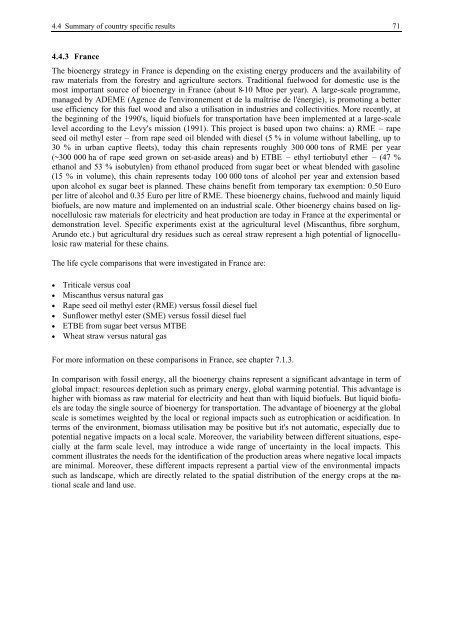BIOENERGY FOR EUROPE: WHICH ONES FIT BEST?
BIOENERGY FOR EUROPE: WHICH ONES FIT BEST?
BIOENERGY FOR EUROPE: WHICH ONES FIT BEST?
You also want an ePaper? Increase the reach of your titles
YUMPU automatically turns print PDFs into web optimized ePapers that Google loves.
4.4 Summary of country specific results 71<br />
4.4.3 France<br />
The bioenergy strategy in France is depending on the existing energy producers and the availability of<br />
raw materials from the forestry and agriculture sectors. Traditional fuelwood for domestic use is the<br />
most important source of bioenergy in France (about 8-10 Mtoe per year). A large-scale programme,<br />
managed by ADEME (Agence de l'environnement et de la maîtrise de l'énergie), is promoting a better<br />
use efficiency for this fuel wood and also a utilisation in industries and collectivities. More recently, at<br />
the beginning of the 1990's, liquid biofuels for transportation have been implemented at a large-scale<br />
level according to the Levy's mission (1991). This project is based upon two chains: a) RME – rape<br />
seed oil methyl ester – from rape seed oil blended with diesel (5 % in volume without labelling, up to<br />
30 % in urban captive fleets), today this chain represents roughly 300 000 tons of RME per year<br />
(~300 000 ha of rape seed grown on set-aside areas) and b) ETBE – ethyl tertiobutyl ether – (47 %<br />
ethanol and 53 % isobutylen) from ethanol produced from sugar beet or wheat blended with gasoline<br />
(15 % in volume), this chain represents today 100 000 tons of alcohol per year and extension based<br />
upon alcohol ex sugar beet is planned. These chains benefit from temporary tax exemption: 0.50 Euro<br />
per litre of alcohol and 0.35 Euro per litre of RME. These bioenergy chains, fuelwood and mainly liquid<br />
biofuels, are now mature and implemented on an industrial scale. Other bioenergy chains based on lignocellulosic<br />
raw materials for electricity and heat production are today in France at the experimental or<br />
demonstration level. Specific experiments exist at the agricultural level (Miscanthus, fibre sorghum,<br />
Arundo etc.) but agricultural dry residues such as cereal straw represent a high potential of lignocellulosic<br />
raw material for these chains.<br />
The life cycle comparisons that were investigated in France are:<br />
• Triticale versus coal<br />
• Miscanthus versus natural gas<br />
• Rape seed oil methyl ester (RME) versus fossil diesel fuel<br />
• Sunflower methyl ester (SME) versus fossil diesel fuel<br />
• ETBE from sugar beet versus MTBE<br />
• Wheat straw versus natural gas<br />
For more information on these comparisons in France, see chapter 7.1.3.<br />
In comparison with fossil energy, all the bioenergy chains represent a significant advantage in term of<br />
global impact: resources depletion such as primary energy, global warming potential. This advantage is<br />
higher with biomass as raw material for electricity and heat than with liquid biofuels. But liquid biofuels<br />
are today the single source of bioenergy for transportation. The advantage of bioenergy at the global<br />
scale is sometimes weighted by the local or regional impacts such as eutrophication or acidification. In<br />
terms of the environment, biomass utilisation may be positive but it's not automatic, especially due to<br />
potential negative impacts on a local scale. Moreover, the variability between different situations, especially<br />
at the farm scale level, may introduce a wide range of uncertainty in the local impacts. This<br />
comment illustrates the needs for the identification of the production areas where negative local impacts<br />
are minimal. Moreover, these different impacts represent a partial view of the environmental impacts<br />
such as landscape, which are directly related to the spatial distribution of the energy crops at the national<br />
scale and land use.

















